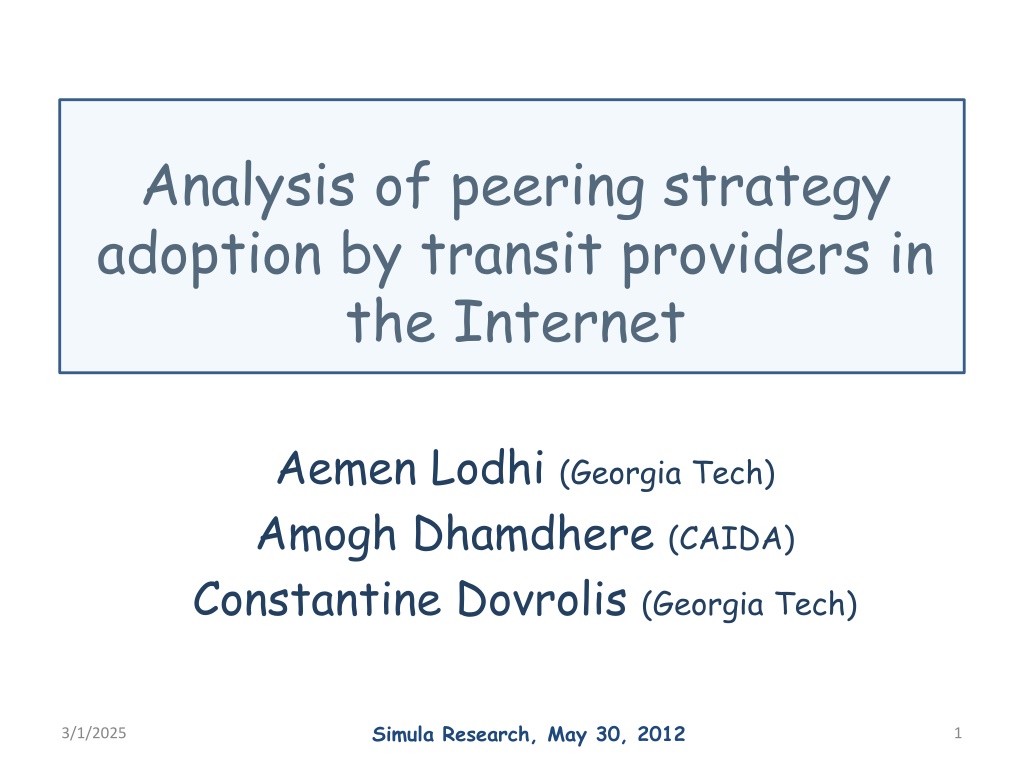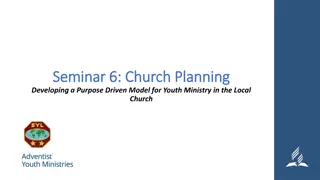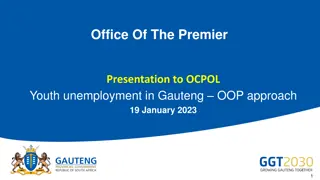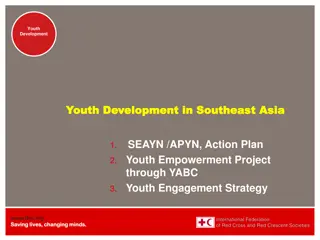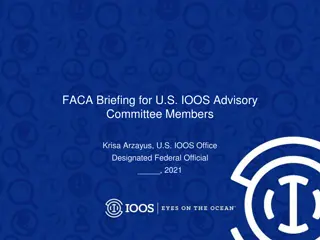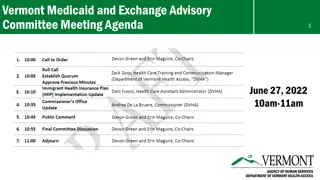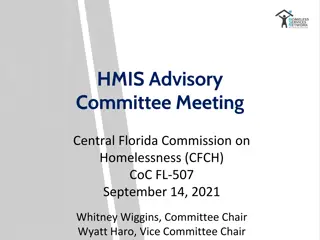LSWA Youth Advisory Committee Meeting Agenda
Join the LSWA Youth Advisory Committee meeting to discuss updates, introduce new program coordinator, RFP solicitation, network updates, agency announcements, and upcoming meeting schedules. Get involved and stay informed about youth programs and opportunities
Download Presentation

Please find below an Image/Link to download the presentation.
The content on the website is provided AS IS for your information and personal use only. It may not be sold, licensed, or shared on other websites without obtaining consent from the author. Download presentation by click this link. If you encounter any issues during the download, it is possible that the publisher has removed the file from their server.
E N D
Presentation Transcript
Analysis of peering strategy adoption by transit providers in the Internet Aemen Lodhi (Georgia Tech) Amogh Dhamdhere (CAIDA) Constantine Dovrolis (Georgia Tech) Simula Research, May 30, 2012 3/1/2025 1
Outline Background Motivation & Objective Approach: the GENESIS model Results Adoption of peering strategies Impact on economic fitness Who loses? Who gains? Alternative peering strategies Conclusion 3/1/2025 2
Pretty picture of the Internet 3/1/2025 3
Background The Internet consists of ~40,000 networks Each independently operated and managed Called Autonomous Systems (ASes) Various types: transit, content, access, enterprise Distributed, decentralized interactions between ASes Transit link: Customer pays provider Settlement-free peering link: Exchange traffic for free 3/1/2025 4
The Internet again..less pretty Tier-1 network Tier-1 network $$ Tier-1 network $$ Transit Provider Transit Provider $$ $$ $$ Enterprise customer Enterprise customer Content Provider Content Provider 3/1/2025 5
Motivation: Existing peering environment Increasing fraction of interdomain traffic flows over peering links* How are transit providers responding? Transit Provider Access ISP/Eyeballs Content Provider/CDN 3/1/2025 6
Motivation: Existing peering environment Peering strategies of ASes in the Internet (source: PeeringDB www.peeringdb.com) Transit Providers peering openly ? 3/1/2025 7
Objective Why are so many transit providers peering openly? What gives them the incentive to do so? What is the impact on their economic fitness? Which transit providers lose/gain? Are their any alternative peering strategies? 3/1/2025 8
The model: GENESIS* Agent based interdomain network formation model Incorporates Geographic constraints in provider/peer selection Interdomain traffic matrix Public & Private peering Realistic peering costs, transit costs, transit revenue 3/1/2025 9
The model: GENESIS* Fitness = Transit Revenue Transit Cost Peering cost Objective: Maximize economic fitness Optimize connectivity through peer and transit provider selection Choose the peering strategy that maximizes fitness 3/1/2025 10
Peering strategies Networks must be co-located in order to establish a peering link Restrictive: Peer only if the internetwork would otherwise be partitioned Selective: Peer only with networks of similar size Use total traffic volume of potential peers as proxy for size Open: Agree to peer with any co-located network 3/1/2025 11
Peering strategy adoption Strategy update in each round Enumerate all available strategies Estimate fitness with the connectivity that results from each strategy Choose the one which gives maximum fitness 3/1/2025 12
Execution of a sample path No exogenous changes Networks have no foresight Networks do not co-ordinate Continues until every network has played, but none has changed its peering strategy 1. Depeering 2. Peering 3. Transit provider selection 1. Depeering 2. Peering 3. Transit provider selection 4. Peering strategy update 4. Peering strategy update 1. Depeering 2. Peering 3. Transit provider selection 4. Peering strategy update Iteration Iteration 1 2 1 2 N N Time 3/1/2025 13
Scenarios Without-open Selective Restrictive With-open Selective Restrictive Open vs. *Stubs always use Open 3/1/2025 14
RESULTS 3/1/2025 15
Strategy adoption by transit providers 100 Percentage of transit providers 90 80 70 60 50 Restrictive Selective Open 40 30 20 10 0 Without-open With -open Conservative Non-conservative Scenarios 3/1/2025 16
Strategy adoption by transit providers Attraction towards Open peering not uniform Less attractive for large transit providers 3/1/2025 17
Impact of Open peering on cumulative fitness Cumulative fitness reduced in all simulations 70% providers have lower fitness 3/1/2025 18
Impact of Open peering on individual fitness Some providers lose significantly due to open peering 3/1/2025 19
An Open peering environment Affects: Transit Cost Transit Revenue v Save transit costs Peering Cost x y But your customers are doing the same! z w 3/1/2025 20
Why gravitate towards Open peering? Options for x? Y reduced transit traffic and revenue for X!! some of its transit traffic x adopts Open peering x y X recovers Not isolated decisions!! Y peering openly z w, traffic passes through x z w z w, z y, traffic bypasses x 3/1/2025 21
Some Game Theory (finally..) Analyzed a simplified model game- theoretically Only two providers, co-located, no economies of scale, each has single customer With complete information about each other s payoffs, providers choose Selective peering In the absence of complete information, Open peering is the risk-dominant strategy 3/1/2025 22
Quantifying traffic stealing Contention metric: Quantify traffic stealing effect No Maximum x y contention Contention z w 3/1/2025 23
Contention and fitness Cumulative fitness of transit providers decreases as traffic stealing becomes more prevalent 3/1/2025 24
Traffic volume and customer cone size Traffic stealing seems to be the root cause of fitness loss Let s classify providers based on how likely they are to steal traffic and have their traffic stolen by peers See what happens to different classes 3/1/2025 26
Classification of transit providers Classification of transit providers Traffic volume, Customer cone size 3/1/2025 27
Who loses? Who gains? 3/1/2025 28
Who loses? Who gains? Who gains: Small customer cone small traffic volume Cannot peer with large providers using Selective Little transit revenue loss Who loses: Large customer cone large traffic volume Can peer with large transit providers with Selective Customers peer extensively 3/1/2025 29
Alternatives: Open peering variants Do not peer with immediate customers of peer (Direct Customer Forbiddance DCF) Do not peer with any AS in the customer tree of peer (All Customer Forbiddance ACF) x y x y w z w v DCF z ACF 3/1/2025 30
Open peering variants: Fitness Selective Open DCF ACF Collective fitness with DCF approaches Selective 3/1/2025 31
Open peering variants: Fitness Why the improvement with DCF? No traffic stealing by peers Aggregation of peering traffic over fewer links (economies of scale !!) Less pressure to adopt Open peering 3/1/2025 32
Open peering variants: Open questions These rules cannot be enforced! What happens if some networks decide to cheat at the eqilibrium? i.e., is the DCF equilibrium stable? Tit-for-tat equibrium Genetic algorithm What if some networks never agree to DCF? Can these networks cause the system to gravitate towards Open peering? Coaalition games Shapley value 3/1/2025 33
Conclusion Gravitation towards Open peering is a network effect for transit providers (79% adopt Open peering) Economically motivated strategy selection Myopic decisions Lack of coordination Extensive Open peering by transit providers in the network results in collective loss 3/1/2025 34
Conclusion Effect on the fitness of transit providers is not uniform Small transit providers gain Large transit providers lose Coordination is required to mitigate losses Not peering with customers of peers can avoid fitness loss 3/1/2025 35
Thank you 3/1/2025 36
Motivation Traffic ratio requirement for peering? (source: PeeringDB www.peeringdb.com) 3/1/2025 37
Traffic components Inbound traffic Traffic consumed in the AS Traffic generated within the AS Traffic transiting through the AS Autonomous system Transit traffic = Inbound traffic Consumed traffic same as Transit traffic = Outbound traffic Generated traffic Outbound traffic 3/1/2025 38
Customer-Provider traffic comparison PeeringDB.com Traffic carried by the AS 3/1/2025 39
Customer-Provider traffic comparison 2500 customer-provider pairs 90% pairs: Customer traffic significantly less than provider traffic 9.5% pairs: Customer traffic larger than provider traffic (difference less than 20%) 0.05% pairs: Customer traffic significantly larger than provider traffic 3/1/2025 40
Peering link at top tier possible across regions overlap Geographic presence & constraints Geographic Link formation across geography not possible Regions corresponding to unique IXPs 3/1/2025 41
Logical Connectivity 3/1/2025 42
Traffic Matrix Traffic for N size network represented through an N * N matrix Illustration of traffic matrix for a 4 AS network Traffic sent by AS 0 to other ASes in the network Intra-domain traffic not captured in the model Generated traffic = G x V ) ( 0 t t t t 01 02 03 N Traffic received by AS 0 from other ASes in the network = x i i , 0 t xi 0 10 Consumed traffic 0 t 20 N = , 0 0 t = ( ) V x t 30 C ix i i x 3/1/2025 43
